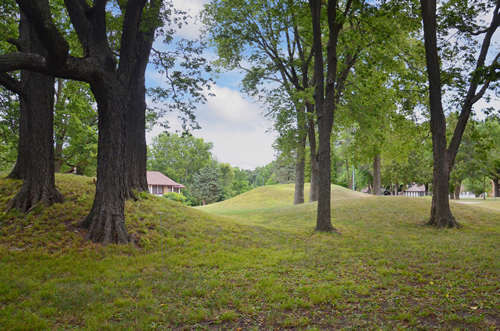Scattered around the landscape of the Great Lakes lies more than 200 individual preserved mounds. In the city of Madison alone there are a dozen mound sites available to visitors in parks and other public spaces. Bring that focus out to all of Wisconsin, and we’re looking at 15,000-20,000 mounds, only 4,000 of which remain today.
For those who may be unfamiliar with the earthwork structures archaeologists call effigy mounds, they are raised piles of earth constructed in the shape of a stylized animal, symbol, religious figure, human or other miscellaneous designs and are a regional cultural phenomenon attributed to the Late Woodland Period, from AD 350 – 1300. To understand the context of an effigy mound, it’s important to look at them with the perspective of Native American beliefs, customs, and worldviews. The various effigy forms correspond to important spirits in the belief structure and clan system of many modern Native American groups.
At the forefront of preservation in the area was Charles E. Brown, museum director at the Wisconsin Historical Society from 1908 – 1944, founder and editor of the Wisconsin Archaeological Society (WAS). After a period of destruction of the mounds around the state, a delegation from Brown’s WAS successfully lobbied the state legislature to enact a law protecting archaeological sites. This was Wisconsin’s first historic preservation law. From the appropriated funds alongside this law, the WAS created a separate section of the group known as the Wisconsin Archaeological Survey who fanned out all across the state documented and mapping effigy mounds. The funds only lasted 2 years, but within that time hundreds of hounds were documented. It would be another half century before state funding for similar preservation work would again be available.
Together with a variety of organizations, the WAS placed historic markers and plaques at mounds on public lands as a means of calling attention to their importance. By the 1920s, 500 mounds had been preserved throughout the state due to the Society’s efforts. In the late 1980s, the city of Madison initiated a program to designate the mounds within its own community as city landmarks, thus offering even more protection. Dane County’s Parks Department joined the preservation efforts in the 1990s with a countywide mound identification project. However, in the late 1990s, federal and state cutbacks slowed preservation efforts and local community groups took over the efforts.
Interested in reading more about the Effigy Mounds in the Great Lakes Region? Check out “Spirits of the Earth: The Effigy Mound Landscape of Madison and the Four Lakes” by Robert Birmingham.




